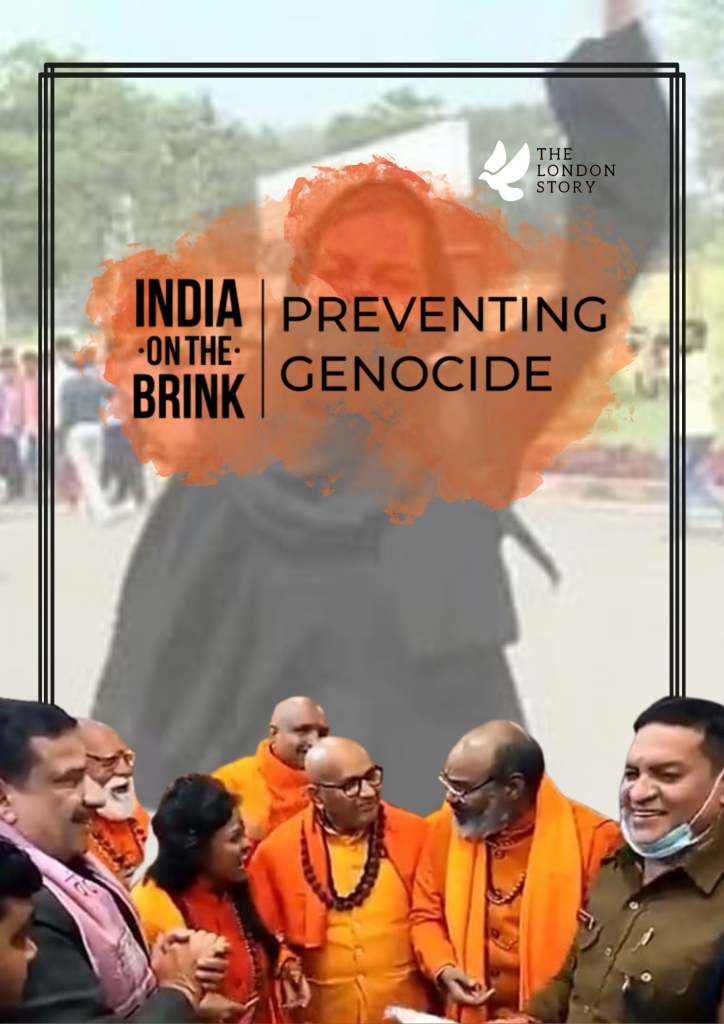Washington, DC / Montreal / London / The Hague / New Delhi, March 1-2, 2022
Since genocide is a process and not an event, India is not merely at the brink of a genocide of its Muslims. The process of genocide is, in fact, already underway in that country, experts said at the conclusion of a three-day global summit, titled, India On The Brink: Preventing Genocide held virtually.
Participating in a panel on “Dehumanization & Polarization: Hindutva Hate Speech,” Greg Gordon, a former attorney with the International Criminal Tribunal for Rwanda, said prosecution for hate speech should be made through the lens of incitement to genocide. “We have had direct calls [for genocide] in India recently,” he said. “Conditional calls – ‘If they do this, we will do that’ – are also incitements.”
“As dehumanization turns into actual incitement to genocide, the process reaches the ‘twilight phase,’ which is when legal action in the genocide framework should commence,” Gordon said. “Abetting” the incitement should be legislated as a new offense to prosecute incitement “in a more comprehensive manner.”
Jean-Damascene Gasanabo, the Director-General of the National Research and Documentation Center on Genocide at Rwanda’s National Commission for the Fight Against Genocide, recalled how the news media in Rwanda played a central role in enabling the genocide of 800,000 Tutsis at the hands of the Hutus.
While the actual genocide occurred in 1994, the process had already begun as early as 1957 when Hutu “intellectuals” published the hate-filled “Hutu manifesto” that intended to “exclude the other groups” and was endorsed by political elites, Gasanabo said. The “10 commandments of the Hutu” published in 1959 stressed that a relationship between the Hutus and the Tutsis was impossible and was like “a chronic illness.”
During the 1994 genocide, Rwandan newspapers linked to the militias re-published the “10 commandments of the Hutu” from 40 years earlier. During those years, political leaders directly funded hate propaganda in the newspapers. Political speeches and slogans “transformed into songs” and radicalized the Hutu youth, Gasanabo said.
When the genocide intensified in March 1994, foreign embassies in Rwanda noted “increased incitement to genocide.” Hate speech continued after the launch of genocide. Rwanda’s president asked the public to “actively participate in the killings.”
Veteran human rights attorney Meetali Jain said she had earlier published a report on hate speech and misinformation in India “of a genocidal character, very much akin” to what has been seen in Myanmar and Ethiopia. Her report listed hundreds of hate-filled posts with millions of views on Facebook during the time India legislated the Citizenship (Amendment) Act (CAA) that “codified Islamophobia and culminated in violence in Delhi that killed many people, most of them Muslim,” she added.
“We advocate for a nuanced understanding of hate speech that takes into account the kind of speech that may not technically qualify as hate speech but still gives people the feeling of wanting to do harm offline,” Jain said. “We need much more experts on staff in social media companies who understand the nuances.”
Jain slammed Facebook for behaving arbitrarily. “We have not seen Facebook taking meaningful action in removing or de-platforming some of the most egregious manifestations of hate speech by others, for example Hindu priests.”
Manavi Atri, a human rights lawyer said India’s Karnataka state, where last month Muslim girls were banned from wearing the hijab to school, had become “a hot spot for hate speech. If this kind of dehumanization continues, we are sure to see similar patterns emerge across Karnataka.”
Participating in a panel titled, “Genocidal Hate Speech & State Responsibility,” Adama Dieng, Special Advisor to the Prosecutor at the International Criminal Court (ICC), said though India had a long and cherished history of peaceful coexistence, intolerance and discrimination on the grounds of religion and belief had increased.
“The tragedy is that the authorities seem to be indifferent,” he said. The international community must “work together to advance tolerance.” Saying that the world needs to recommit to the motto of “Never Again,” Dieng said. “We should move to action.”
Alishaan Jafri, an Indian journalist who documents anti-Muslim violence in India, said such violence was applauded by the Indian government and federal ministers. He pointed out that attacks on Muslims took various forms. At the time of the covid crisis, prominent Muslims were attacked. There is “no dog whistle. People can simply say, ‘I want to kill Muslims and this is how I will kill Muslims,’ and they get away with it.”
Kaushik Raj, another Indian journalist, said mob lynchings of Muslims shot up after Modi became prime minister in 2014. The government’s response was that after one lynching, of Mohammad Akhlaq in Uttar Pradesh, the government offered jobs to the killers. In a false case of violence in Delhi, 16 of the 18 accused are Muslims. “Police did not consider the role of those who openly incited violence,” Raj said.
Participating in a panel titled, “The Big Lie: Power of Propaganda,” Dr. Angana Chatterji, researcher-scholar at UC Berkeley, said persecution in India was targeting not just Muslims, but Dalits, Adivasis, and others, too. “The campaign is driven on the ground and social media, and it also has branches in the UK and the US.”
Jason Stanley, a professor of philosophy at Yale University, said Hindutva was part of a “global fascist movement. Ultra-nationalists see this as their time.” There was a “direct causal link” between the Nazis and Hindutva. “The early thinkers of the RSS made explicit suggestions that India should follow the Nazi’s model,” he said. “The CAA looks frighteningly like the Nuremberg laws. There is a movement to strip from Muslims the right to have rights. The map is extremely clear.”
Saying that his parents were Holocaust survivors, Prof. Stanley said the “structure” of persecution in India was “classic fascism… The Hindutva ideology tells us there was a mythical history, where India was pure. They use the language of corruption and infestation. We know that pre-genocide, there are years. It takes years before it unfolds. But we’re clearly seeing the structure of fascism.”
Ayushman Kaul, a researcher with US-based think-tank, Atlantic Council, said “special interests” were leveraging digital communication platforms to “create the in-group, specify the out-group, and, over time, dehumanize the out-group.” The civil society, academia, and the government must come together to stop the hate-mongering.
Participating in a panel titled, “India’s Responsibility to Protect Muslims,” journalist Raqib Hameed Naik said the Rohingyas from Myanmar may face genocide in India, too. While the administration in the Indian province of Jammu and Kashmir demonized the Rohingya refugees, the BJP made it into a “nationwide anti-Muslim discourse.”
The BJP bigots worked actively to deport Rohingyas, Naik said. “How can Rohingya refugees be safe in a country whose own Muslim population is facing an impending genocide?”
Maung Zarni, a researcher at the Genocide Documentation Center in Cambodia said, “I believe that India is not only on the Brink but is already in the process of an unfolding genocide.” Drawing a parallel between India and Burma, he said India portrayed the majority Hindus as under threat or siege from the vulnerable minority.
“The killers portray these vulnerable populations as a security threat to their religion. When this dehumanization begins, the country is already deep in the genocidal process even though the killings may not have started,” he added.
Participating in a panel titled, “Investigating and Monitoring Genocide in India,” Arjun Sethi, a law professor in Washington, D.C., said the data from the Indian government painted a “very distorted picture” as there was a lack of repercussions for hate crimes. “Some perpetrators are celebrated and admitted to the Modi cabinet,” he added.
Christopher Tuckwood, the executive director of the Sentinel Project, a Canadian nonprofit, said preventing genocide in India would be difficult as the state was both the perpetrator and an active protector of other perpetrators.
Mohan Dutta, a professor from New Zealand who Hindu supremacists recently targeted, said Muslims were frustrated at Facebook’s failure to take down hateful content, such as comparing Muslims to pigs and dogs, even after it was flagged. “Research suggests that dehumanization is a key component to violence,” he said.
Nicole Widdersheim of the US Holocaust Memorial Museum said India was “second” at risk for mass killing, as reported in the annual risk report at the Center for the Prevention of Genocide of the Holocaust Memorial Museum. Early warning strategies could be “as simple as a phone tree” where people spread the word, hot spot mapping where you go into communities and discuss tensions, actor mapping where potential perpetrators are identified, scenario planning where you prepare for the worst case.
Participating in a panel titled, “India’s Role in Global Islamophobia,” Hatem Bazian, a professor of Islamic law at Zaytuna College in the US, said Muslims were facing genocides across the world, including in China, India, Myanmar, Palestine, and Kashmir.
“It is not only the governing states and policies that are removing the hijab but the whole rejection of Muslims in the society as Muslims, with the full articulation of citizenship and protection that is accorded in relation to the constitution,” he said.



